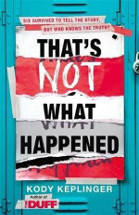That's not what happened by Kody Keplinger

Hodder Children's Books, 2018. ISBN: 9781444933628.
Recommended for older students but with a warning about post
traumatic sensitivities. Themes: gun violence, trauma and anxiety,
post-traumatic stress, faith, loss, personal accounts. It is three
years since a shooter at the small, strongly Christian, Virgil
County High School killed nine; Leanne (Lee) Bauer is one of the six
witnesses who survived the shooting. Lee's best friend Sarah was
shot while they were hiding in a toilet cubicle and died holding her
hand. Lee, like the others was traumatised by the event and its
aftermath of media frenzy and their stories have become 'tangled
into a knot of fact and fiction' p2. She is troubled by the false
story attached to Sarah about a cross necklace and her refusal to
deny her faith when questioned about it by the shooter. When Sarah's
parents announce they are going to publish a book about their
daughter's brave sacrifice, Lee realises she must tell the true
story even if it is not one people want to hear. As a tribute to the
nine victims she asks the other five survivors to write their true
recollections of each victim and how they died that day. She makes a
considered choice to keep the shooter's name out of it. 'This was
the one thing that wasn't about him or why he did it. This was about
everyone else and the damage he had done.' p 19. Four of the
survivors meet and communicate regularly, the only people who truly
understand the traumatising effect of the shooting, but one, Kellie
Gaynor left the district. Lee finds it difficult to trace her and
discovers that while she was recovering from the trauma Kellie was
bullied and called a liar after claiming the necklace as her own.
Even though it means revisiting the event Lee is determined to tell
the truth and in doing so put the record straight before the
survivors leave the school taking their stories with them. In asking
for their stories Lee discovers more about each of the survivors and
how they have coped, ranging from reinforcing Christian belief to
advocating for gun control and she gains strength from them.
We all have a right to tell our own story, except when we are not
here to tell it. The stories told by the survivors about the victims
allow different points of view and appear on pages edged in black.
Their own stories are about struggling to survive as damaged victims
after an unthinkable event that seems to be happening too often in
America.
Sue Speck